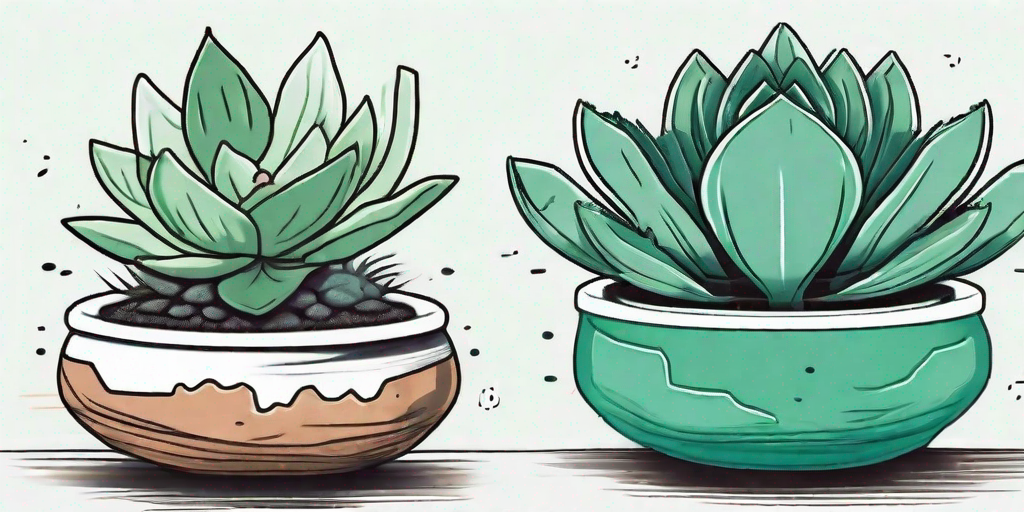
If you're a plant parent, you know the heartbreak of watching your green baby turn brown and wilt. But don't despair! Even if your succulent looks like it's on its last leaf, there's still hope. In this guide, we'll show you how to nurse your plant back to health and prevent future rotting. So put on your gardening gloves, grab your watering can, and let's get to work!
Identifying the Problem
Before you can save your succulent, you need to figure out what's wrong with it. Is it really rotting, or is it just having a bad day? (Yes, plants can have bad days too.)
Rot is usually caused by overwatering. If your succulent's leaves are turning yellow or brown, becoming mushy, and falling off easily, it's likely suffering from rot. In severe cases, the stem may also be soft and discolored. If your plant is just a bit droopy or has a few dry leaves, it might be under-watered or in need of some TLC, but it's probably not rotting.
Overwatering vs Underwatering
It's easy to confuse overwatering with underwatering, as both can cause your succulent to look less than its best. However, there are some key differences. Overwatered plants are usually mushy and discolored, while underwatered plants are dry and may have wrinkled leaves. If you're not sure which is which, remember this: when in doubt, hold off on the water. It's easier to revive a thirsty plant than a drowned one.
Another clue is the color of the leaves. Overwatered plants often have yellow or brown leaves, while underwatered plants have pale, faded leaves.
Reviving Your Rotting Succulent
Now that you've diagnosed the problem, it's time to play plant doctor. Here's a step-by-step guide to reviving your rotting succulent.
Step 1: Remove the Rot
The first step is to remove any rotten parts of the plant. This might seem drastic, but it's necessary to prevent the rot from spreading. Use a clean, sharp knife or pair of scissors to cut away the affected areas. Be sure to sterilize your tools before and after to avoid spreading any diseases.
Once you've removed the rot, let the plant dry out for a few days. This will help to heal the cuts and prevent further rotting.
Step 2: Repot the Plant
After your plant has had a few days to dry out, it's time to repot it. Choose a pot with good drainage and fill it with a well-draining soil mix. Succulents prefer sandy or gritty soil that doesn't hold too much water.
Place your plant in the new pot and gently backfill with soil, being careful not to damage the roots. Don't water the plant right away - wait a few days to let it settle in.
Step 3: Adjust Your Watering Schedule
Now that your plant is in its new home, it's time to adjust your watering schedule. Remember, overwatering is the main cause of rot, so less is more. Wait until the soil is completely dry before watering again, and then water thoroughly.
Keep an eye on your plant over the next few weeks. If it starts to perk up, you're on the right track. If not, you may need to adjust your care routine further.
Preventing Future Problems
Reviving a rotting succulent is no small feat, so give yourself a pat on the back! But your work isn't done yet. Now that you've saved your plant, it's important to prevent future problems.
Watering Tips
As we've mentioned, overwatering is the main cause of rot in succulents. To avoid this, always let the soil dry out completely before watering again. And when you do water, do it thoroughly. A good rule of thumb is to water until it starts to come out of the drainage holes in the bottom of the pot.
Also, remember that succulents need less water in the winter when they're dormant. During this time, you can cut back on watering.
Light and Temperature
Light and temperature also play a role in your succulent's health. Most succulents prefer bright, indirect light and temperatures between 60 and 80 degrees Fahrenheit. If your plant isn't getting enough light, it may become leggy and weak. If it's too hot or cold, it may become stressed and more susceptible to diseases.
Try to keep your succulent in a spot where it gets plenty of light, but not direct sun, which can scorch the leaves. If you live in a cold climate, consider getting a grow light for the winter months.
Frequently Asked Questions
Why is my succulent rotting?
Overwatering is the most common cause of rot in succulents. If the soil is constantly wet, it can lead to root rot, which can spread to the rest of the plant if not treated.
Can a rotting succulent be saved?
Yes, a rotting succulent can often be saved if the rot is caught early and the plant is given proper care. This includes removing the rotten parts, repotting the plant in fresh, well-draining soil, and adjusting the watering schedule.
How often should I water my succulent?
There's no one-size-fits-all answer to this, as it depends on the type of succulent, the size of the pot, the type of soil, the climate, and the time of year. However, a good rule of thumb is to let the soil dry out completely between waterings.
Conclusion
So there you have it, plant parents! With a little TLC, your rotting succulent can be revived and thrive once again. Remember, the key to healthy succulents is proper watering, light, and temperature. Now go forth and save those succulents!















